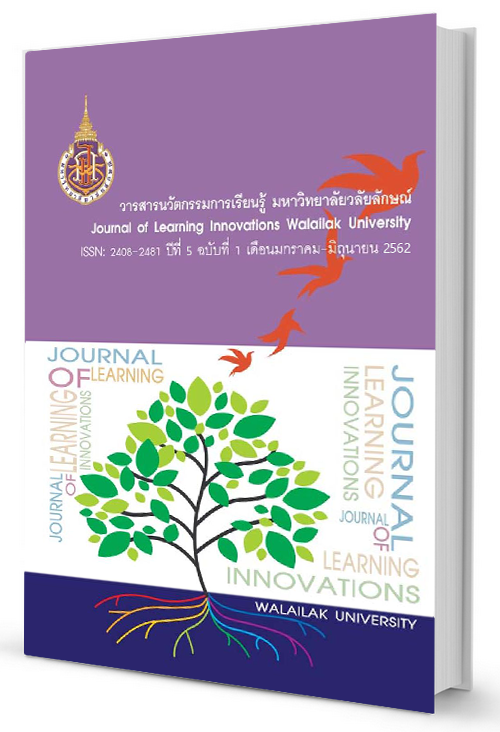Evaluating the impact of model-based inquiry with model-evidence link on grade 11 students’ scientific explanation of electrolyte and non-electrolyte solution
DOI:
https://doi.org/10.14456/jli.2019.4Keywords:
model-based inquiry, model-evidence link, scientific explanationAbstract
Scientific explanation has been regarded as an essential goal in science education research. To help students learn in science classroom, a teacher should provide rich opportunities for students to gain experience in explaining scientific phenomena. This research aimed to study students’ scientific explanation ability of electrolyte and non-electrolyte solutions learned through using model-based inquiry with model-evidence link. Participants were 34 grade 11 students who were studying at a high school in Khon Kaen. The scientific explanation test and scientific explanation form were used to assess students’ written their explanation based on the claim, evidence, and reasoning framework. The findings reveal that before learning most students had could make a claim and select evidence to support their claim correctly, but they experienced difficulty to give scientific reasoning to link between such a claim and evidence. After learning, most students could improve their scientific explanation ability. They were able to identify three components of scientific explanation completely. This research indicates that model-based inquiry with model-evidence link was able to support students to have better scientific explanation ability.
References
Brigandt, I. (2016). Why the difference between explanation and argument matters to science education. Science & Education, 25(3), 251-275.
Dass K., Head L. M., & Rushton T. G. (2015). Building an understanding of how model-based inquiry is implemented in the high school chemistry classroom. Journal of Chemical Education, 92, 1306−1314.
Jingying W., & Donghui G., & Min J., (2015). A study on the effects of model-based inquiry pedagogyon students’ inquiry skills in a virtual physics lab. Computers in Human Behavior, 49, 658-669.
Harizal Z. M. (2012). Analyzing of students’ misconceptions on acid-base chemistry at senior high schools in medan. Journal of Education and Practice, 3(15), 65-74.
The institute for the Promotion of Teaching Science and Technology. (2012). Professional Science Teachers: . Bangkok, Thailand: inter education supplies
The institute for the Promotion of Teaching Science and Technology. (2015). Programme for International Student Assessment 2015. Bangkok, Thailand: advance printing service co., ltd.
Lehrer, R., & Schuable, L. (2012). Cultivating model-based reasoning in science education. Handbook of the learning sciences, New York, USA: Cambridge University Press.
Lombardi, D., Sinatra, M. G., & Nussbaum, M. (2013) Plausibility reappraisals and shifts in middle school students' climate change conception. Learning and instruction, 27, 50-62.
McNeill K. L., & Krajcik J. (2008). Scientific explanations: Characterizing and evaluating the effects of teachers’ instructional practices on student learning. Journal of research in science teaching. 44(1), 53-78.
M.S. Khine, I.M. Saleh (eds.). Model and modeling. Model and modeling in science education 6. DOI 10.1007/978-94-007-0449-7_10.
Meela P., & Artdej R. (2017). Model-based inquiry and scientific explanation: Promoting meaning- making in classroom. Journal of Education Naresuan University, 19(3), 1-15.
Mulford R. D., & Robinson R. W. (2002). An inventory for alternate conceptions among first- semester general chemistry students. Chemical Education Research. 79(6), 739-744
Oh, P. S., & Oh, S. J. (2011). What teachers of science need to know about models: an
overview. International Journal of Science Education, 33(8), 1109-1130.
Prins G. T., Bulte A. M. W., Van Driel J. H., & Pilot A. (2008). Selection of authentic modeling practices as contexts for chemistry education. International Journal of Science Education, 30(14), 1867-1890.
Porntep Juntraukrit (2015). Development of an instructional model by integrating the argument
- driven inqury model and model-base leaning approach to promote scientific literacy competencies and rationality of lower secondary school student. Silpakorn Educational Research Journal 7(2), 232-248
Supaporn Inboonna. (1998). Misconceptions in acid-base of upper secondary school level students in changwat Nakhon si thammarat Master of Education Thesis in Science and Technology Education, Graduate School, Prince of Songkla University.
Windschitl M., Thompson J., & Braaten M. (2008). Beyond the scientific method: Model-based inquiry as a new paradigm of preference for school science investigations. Science could improve their scientific explanation ability. They were able to identify three components of scientific explanation completely. This research indicates that the model-based inquiry with the model-evidence link was able to support students to have better scientific explanation ability.
Downloads
Published
How to Cite
Issue
Section
License
เนื้อหาและข้อมูลในบทความที่ลงตีพิมพ์ในวารสารนวัตกรรมการเรียนรู้ มหาวิทยาลัยวลัยลักษณ์ ถือเป็นข้อคิดเห็นและความรับผิดชอบของผู้เขียนบทความโดยตรง ซึ่งกองบรรณาธิการวารสาร ไม่จำเป็นต้องเห็นด้วย หรือร่วมรับผิดชอบใดๆ
บทความ ข้อมูล เนื้อหา รูปภาพ ฯลฯ ที่ได้รับการตีพิมพ์ในวารสารนวัตกรรมการเรียนรู้ มหาวิทยาลัยวลัยลักษณ์ ถือเป็นลิขสิทธิ์ของวารสารนวัตกรรมการเรียนรุ้ มหาวิทยาลัยวลัยลักษณ์ หากบุคคลหรือหน่วยงานใดต้องการนำทั้งหมดหรือส่วนหนึ่งส่วนใดไปเผยแพร่ต่อเพื่อกระทำการใดๆ จ้อต้องได้รับอนุญาตเป็นลายลักษณ์อักษรจากวารสารนวัตกรรมการเรียนรู้ มหาวิทยาลัยวลัยลักษณ์ก่อนเท่านั้น


